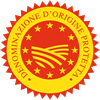Description
The Maine-Anjou PDO is fresh meat from neuter bovine with more than 30 months of age and female bovine aged of less than 10 years (which calved at least once) from the Rouge des Prés breed.
Production Area
The production area of Maine-Anjou PDO covers many municipal areas in the departments of Ille-et-Vilaine in region Brittany; Loire-Atlantique, Maine-et-Loire, Mayenne, Vendée and Sarthe, in region Pays de la Loire; Deux-Sèvres, in region Poitou-Charentes, and Orne, in the region of Lower Normandy.
Production Method
The cattle for the production of Maine-Anjou PDO, unless bad weather conditions, are pastured for a period between March 15th and November 15th. At the beginning, the feeding consists of fodder without siloed maize forage. During the finishing phase, which has to last at least two months, the animals are nurtured with raw grass, hay and energetic and protein complements. The use of siloed forage is not allowed. 48 hours before slaughtering, the cattle have to be nurtured with only hay and water and kept in places with a lot of straw. The preparatory slaughtering operations have to take place in order to reduce the animals' stress to the minimum. The transport time from breeding to slaughterhouse has to last less than six hours and the cattle have to be stunned within five seconds from the arrival to the slaughterhouse. The time between the animals' unloading and the end of operations cannot last more than three hours. The carcasses undergo a ventilation process to keep a suitable internal temperature even after 10 hours from slaughtering. Finally, they are subdivided into the different suitable slices for commercialisation.
Appearance and Flavour
Maine-Anjou PDO is bold red tending to orange in colour and the meat is characterised by intramuscular veins. It is very juicy and with a tender consistency.
History
The Maine-Anjou bovine breed (become Rouge des Prés in 2003) was officially recognised for the first time in 1908. The identity of this breed, which is typical from the French mountainous Massif Armoricain, was given by Olivier de Rougé, Transalpine politician, and member ofAcadémie d'Agriculture. This particular breed is different from the others and owes its big size to the features of the production area, which is very dry and rich in rough forages which require a good capacity of ingestion. Therefore, from 1908 up to now, the history of bovine dedicated to the production of Maine-Anjou PDO is closely linked to the features of the Massif Armoricain area.
Gastronomy
Maine-Anjou PDO meat has to be stored in refrigerator as any other fresh meat. The product can be eaten raw as a carpaccio or after cooking. It is very good barbecued or grilled with the addition of a bit of oil and salt.
Marketing
The product is sold as Maine-Anjou PDO. It can be sold raw in whole carcasses or in specific slices put in suitable packaging or vacuum-packed.
Distinctive Features
The Maine-Anjou PDO meat is highly appreciated for its tenderness to the cut and the palate.






